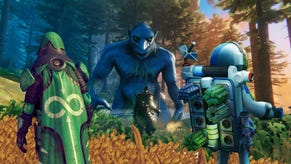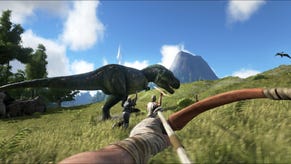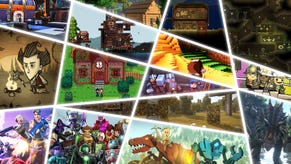Ark Survival Evolved Base Building Guide
How to defend yourself from attack
Once you’ve made it through your first few minutes on the island without dying (congrats!), you’ll want to consider building a base. A well-designed base will protect you from the elements, keep your gathered resources and supplies secure, provide a place to keep your crafting, cooking and farming equipment, and - most importantly - protect you and your creatures from the island’s hostile forces.
Whenever you log out of ARK: Survival Evolved’s servers, your body remains exactly where you left it, susceptible to attack from predators and, if you’re on a PvP server, other players. As such, a secure base is an absolute must if you don’t want to log back on to discover that you’ve become a glum-faced corpse, stripped of your hard-earned spoils.
For more Ark Survival Evolved advice, check out our beginner's tips, island guide, resource, recipe, and crafting guide, and Ark taming guide.
Building Your First Base
In order to build your first base, you’ll need to understand the basics of levelling and Engrams, resource gathering and crafting, and you should have assembled at least a couple of simple tools - ideally, a hatchet and pick. If you need a refresher on any of that, feel free to check out the earlier chapters in this guide.
Where To Build Your Base
When you’re ready to establish your first base, you’ll ideally want to find a spot that offers easy access to the game’s most frequently-used resources - namely Wood, Thatch, Fibre and Stone. As mentioned previously, the beaches where most players start aren’t the most resource-rich areas in the game - so, once you’re equipped for basic survival, you should consider moving inland a little, away from the often heavily-populated coast.
Additionally, you should attempt to establish your starter base close to a source of water, such as a river or stream. Not only will this make it easier to quench your thirst and combat extreme heat, it will prove invaluable when it comes to cooking and farming.
A Note On Pillars
Depending on the type of server you join, you might quickly discover that much of the island has already been claimed by other tribes, making it tough to set up a base of your own. Often, tribes will reserve land to prevent others from building nearby, usually by placing down foundations or pillars. Pillars, unlike foundations, don’t block valuable resources from spawning around them, so you’ll likely see them most.
If you’re struggling to find a spot to set up base, you’ve two options: either try a different server or consider moving further inland. The island’s beaches are generally its most populated area - largely because that’s where new players set up camp and never really move on. It shouldn’t take long to find somewhere to build once you move away from the ocean - just be sure to avoid swamps and the perilous north until you’re better prepared.
What To Build
When it comes to base building, you can be as practical, or as fanciful, as you please. All bases will share a number of core elements, of course - and you’ll have slightly different requirements depending on whether you play on a PvP server or PvE. Initially, however, all you’ll need to build is a place to keep you safe from the world outside - so four walls, a ceiling and a foundation to put it all on should suffice.
Building Materials
Currently, there are four tiers of building materials in ARK: Thatch, Wood, Stone and Metal, and each affords greater protection than the last. A thatch wall, for instance, offers 1,600 damage resistance, while its wood, stone and metal counterparts have 10,000.
In practical terms, almost anything can destroy a thatch structure, while wooden structures are sturdy enough to keep out most mid-sized creatures. Stone structures can withstand attack from everything but alpha predators (the glowing, super-tough raptor and T. rex variants), as well as bosses, the Giganotosaurus, ballista turrets, explosives and metal weapons. Finally, metal structures are impervious to everything but explosives. Things are slightly different on PvE servers, of course, where only wildlife can damage your base.
As mentioned previously, you’ll need to level up before you can access the building Engrams required to start work on your base. The earliest available building Engrams come from the Thatch tier of structures, with the Thatch Foundation and Doorframe unlocking at Level 2, and the Thatch Door, Walls and Ceiling unlocking at Level 3.
You’ll need plenty of Thatch, Wood and Fibre to begin building - so consider gathering resources early on in order to level up and gain the required Engram Points as you work.
Putting It All Together
When you’ve gathered everything you need, it’s time to start building your base. Regardless of the material you’re using, you’ll always want to lay down a foundation first. You can snap up to four wall pieces to each foundation (or three walls, a doorframe and a door, if you prefer), and a roof piece then rests on your walls. Roof pieces will function as floors if you decide to build further levels above, and these in turn will support more walls. Thatch roofs are the exception here, however, and won’t support a second story.
Incidentally, if you ever want to flip an item that you’re trying to place, simply press “E”. Additionally, should you be unhappy with an item once it has been placed in the world, you can demolish it to recoup half of its original resource cost.
Once your base has a floor, a roof and completely enclosed sides, it will provide a degree of protection from the island’s extreme temperatures (as denoted by the small house icon that appears on your HUD while you’re standing inside).
On page two, how to defend your base from attack, furnish your base with useful items, and how to farm food.
With your tiny insulated cube in place, you’ve successfully created your first base. However, it probably isn’t very secure; before doing anything else, ensure that all doors leading into your home are locked or pinned to stop intruders from simply waltzing on in. You should also get into the habit of always closing doors behind you - even on PvE servers, an open doorway can prove a little too tempting for other players, and you’ll likely find that your hard-earned resources get pilfered if you don’t remember to shut up tight.
How To Defend Your Base
Due to the game’s currently wonky collision detection, most predators can attack through walls. As such, don’t assume that leaving your body in your hut will be enough to protect you from outside forces whenever you log off. To be truly safe, you’ll want to consider building a perimeter fence around your base.
To build a fence you’ll need to lay a Wooden Fence Foundation (or its stone and metal equivalent) down on the ground, then snap a wall piece on top. To unlock the Wooden Fence Foundation Engram, however, you’ll need to reach Level 15.
Fence foundations snap together at the ends, making fence construction a relatively easy process. Initially, you’ll want to add doorframe pieces to your fence so that you can get outside. Later, however, you can add variously-sized gateway and gate pieces to your perimeter fence, enabling you to move larger creatures in and out of your compound. The first of these - the Dinosaur Gate and Dinosaur Gateway - unlocks at Level 15.
When constructing your fence, remember that dinosaurs are pretty big things; as such, you should aim to build a fence that’s around 4-5 pieces high. This should keep even the biggest creature from simply waltzing over the top and into your base.
Don’t forget, however, that the island is home to many flying creatures, including the Pteranodon, Quetzal and Argentavis. As a result, you’re still susceptible to infiltration and attack from above - even on PvE servers, you can expect egg thieves to hover overhead, waiting to snatch your delicious, yolky wares. Always ensure that your valuables are kept inside, even if it means building a second structure to house them.
Furnishing Your Base
Once the shell of your base is complete, it’s time to start furnishing your new island home. Alongside secure storage (ranging from the 12-slot Storage Box and 30-slot Large Storage Box, right through to the 150-slot metal Vault), there are a number of other essential items that you’ll want to add to your base as it expands.
First and foremost, you’ll want to craft a Simple Bed, enabling you and your tribe mates to re-spawn directly inside your base when you die, rather than at one of the island’s starting zones. Beds can be used once every five minutes and, as an added bonus, allow fast travel to other beds and Sleeping Bags owned by your tribe.
Next, you’ll want to begin equipping your base with basic crafting and cooking implements. At a bare minimum, you should build a Campfire (available at Level 2) to cook meat and keep yourself warm, a Mortar and Pestle (Level 5) to craft Sparkpowder and Narcotics, a Cooking Pot (Level 10) to make recipes and dyes - which can be used to add a welcome splash of colour to your walls, clothes and items - plus a Preserving Bin (Level 20) to keep perishable goods like meat and berries fresher for longer.
Later, you’ll want to incorporate advanced crafting items into your home, such as the Smithy and Refining Forge, in order to complete more advanced Engrams. Additionally, most crafting and cooking items have high level variants (such as the Industrial Grill, Industrial Cooker, Industrial Forge and Refrigerator) for greater efficiency.
How To Farm Food
Sooner or later in your ARK adventure, you’ll want to begin experimenting with farming. Farming lets you produce fruit and vegetables that can’t be found elsewhere on the island, and that are essential ingredients in recipes and dinosaur kibble. To grow crops, you’ll need two things: seeds (harvested from bushes) and a Crop Plot. Crop Plots come in three sizes: Small, Medium and Large, with certain seeds only growing if there’s enough room.
Additionally, each Crop Plot must have water and be fertilised. Rainfall will water Crop Plots, or you can water them manually using a Waterskin, Water Jar or Canteen. If you plan to do a lot of farming, however, you might want to set up a permanent irrigation system using pipes that draw water from the ocean, river or a man-made Water Tank; pipes will turn blue if they are correctly drawing water.
To fertilise a Crop Plot, meanwhile, you can place collected feces inside - human feces will last around 10 minutes, while Large Animal Feces can fertilise your crops for around two and a half hours. It’s better, however, to use Fertiliser, which is created by leaving any three Feces and 50 Thatch in a Compost Bin for around 50 minutes. Fertiliser lasts for around 9 hours in a Crop Plot. If you’re struggling to find a regular supply of Feces, you can force-feed Stimberries to a tamed Phiomia, making it poop dramatically.
Once your Crop Plot is watered and fertilised, you’re ready to plant your chosen seed. Seeds go through several different stages before they reach fruition: Seeded, Seedling, Midling, Growthling and Fruitling. It should take around one real-life day for a seed to be ready to harvest. Note that fully-grown crops will spoil over time unless they’re picked and stored in a Preserving Bin or Refrigerator - so keep a close eye on them.
Basic Dinosaur Care
Of course, the other major function your base serves is as a paddock/hatchery/amazing zoo for all the creatures that you’ve tamed. By and large, creature storage is pretty self explanatory, but there are a few things you should be aware of.
Firstly, some creatures (such as the Brontosaurus and T. rex) are absolutely huge. As such, you’ll almost certainly need to expand your base over time. Make sure that there’s sufficient room for expansion when establishing your base, and consider reserving nearby territory with a couple of wooden pillars. You should also think ahead and ensure that you’ve fitted a suitably-sized dinosaur gate before taming larger beasts - there’s nothing worse than coming home after a long day’s tame and discovering that your playful new Giganotosaurus won’t fit through the door.
As your menagerie grows, you’ll soon realise that feeding multiple creatures can be a huge pain. Luckily, the Feeding Trough is here to help! If you craft a trough and fill it with food, any tribe creature in range (as denoted by the trough icon above its head) will automatically eat from it when hungry - meaning that you don’t have to run around feeding each creature in turn. Note, however, that other players can steal from an open trough, so consider encasing it in a small hut, with access provided through a covered window or locked door. This will keep its contents safe, while still enabling your creatures to feed.
PvE Structure Decay
There’s one last, extremely important, base-related thing to be aware of on PvE servers. If there are no members of your tribe logged into the server, a countdown timer will activate. Once this timer reaches zero, other players can destroy your structures. The length of the timer depends on the material your structures are made from: Thatch structures can be demolished after 4 days, wood structures after 8 days, stone structures after 12 days and metal structures after 16 days. To reset the countdown, simply log back into the server and move within range of your base (or bases!).












